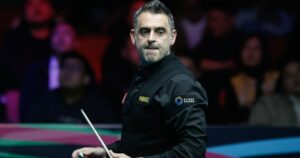### The Advanced Camera Technology Behind “Adolescence”
Innovations in filmmaking technology are transforming the way stories are being captured and told, as exemplified by the Netflix series “Adolescence.” With its ambitious storytelling and stunning visuals, the show managed to attract over 120 million viewers globally within its first month. Central to the success of such projects is the cutting-edge camera technology that allows for long unbroken takes, thus enhancing the overall viewing experience.
One of the most striking features of “Adolescence” is its use of a “oner,” a filming technique where an entire scene is shot in a single take. This technique was employed across all four episodes of the series, allowing for a dynamic flow that mimics real life. Cinematographer Matthew Lewis, in a recent interview, credited advancements in camera technology for making such elaborate filming possible. The series opens with a gripping scene that features police officers storming into a house and arresting a teenager—a sequence executed flawlessly in just three minutes without any cuts.
### The Role of Camera Technology
The ease and fluidity of filming are made possible by lightweight, self-stabilizing cameras that can adapt to rapid changes in lighting and movement. For instance, at the end of the second episode of “Adolescence,” the camera seamlessly transitions from inside a car to soaring over streets, showcasing the adaptability of the technology. The DJI Ronin 4D, specifically, is a notable player in this space, as it incorporates built-in sensors that allow for real-time movement compensation. This results in smooth, stable footage that feels fresh and engaging to the audience.
With close collaboration between the camera operators and the evolved technology, the filmmakers could switch comfortably between different filming modes—be it handheld shots or drone-mounted views—without the audience noticing any jarring transitions. The minimal wobble detectable during these transitions is overshadowed by the captivating storytelling.
### Expert Insights: The Impact of New Technologies
Seasoned filmmakers like Tim Palmer, who teaches at Boston University, recognize the profound impact of these technological advancements on storytelling. He noted that the quality of single takes in “Adolescence” feels incredibly polished compared to past methods used in earlier series such as “Critical,” which often relied on less precise joystick controllers for camera movement. Palmer emphasized that the rise of advanced gimbals and stabilizing devices has opened new doors for filmmakers, allowing them to craft more dynamic narratives.
In contrast, the filmmakers’ attempts to create dynamic environments in series like the 1990s BBC drama “Cardiac Arrest” lacked the fluidity found in “Adolescence.” Although these series employed complex camera techniques, they often felt robotic and choppy. Modern technology, equipped with remote controls for filters and stabilization, brings versatility that’s reshaping the landscape of film and television.
### Long Takes: A Historical Perspective and Future Trends
While one continuous shot is not a new concept in cinema, modern advancements have made it increasingly feasible. For example, the director of the film “Victoria” claimed his work featured a real-time single take, although skeptics have questioned this. Nevertheless, cinematographer Sturla Brandth Grøvlen noted that the slight shakiness of the footage was a deliberate choice, aimed at mimicking the gritty realism found in news coverage of war zones.
DJI’s Ronin 4D exemplifies this technology transformation, being the company’s inaugural dedicated cinema camera with significant stabilization features. While tools like the Ronin are crucial for current filmmakers, some limitations still exist, such as the lack of vertical filming options—which have become increasingly relevant in the age of social media. Canon’s lightweight Cinema EOS series is another example of how manufacturers are adapting to the needs of modern filmmakers, providing versatile options for various filming conditions.
### Conclusion: The Balance of Innovation and Storytelling
As camera technology becomes more sophisticated, it is essential for filmmakers to ensure that the focus remains on storytelling rather than mere technical wizardry. Booker T. Mattison, a screenwriter and educator, believes that the evolution toward ergonomic cameras enhances the capacity for filmmakers to convey dynamic narratives. Nevertheless, there is a cautionary perspective as well; the risk exists that the fascination with long takes may overshadow the fundamental aspects of narrative quality. According to Professor Palmer, the novelty of a one-take film shouldn’t eclipse the need for compelling storytelling, highlighting that technical prowess must serve the story rather than define it.
Through continuous innovation and a focus on narrative, the future of filmmaking looks brighter than ever, with cameras enabling storytellers to push boundaries further while keeping meaningful content at the forefront. Advanced technology reminds us that while aesthetics matter, it is the heart of the story that resonates with viewers.











